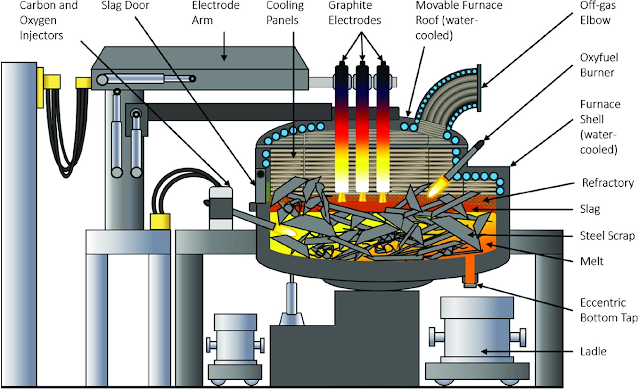Electric Arc Furnace VS Medium Frequency Induction Furnace
Nowadays, there are two kinds of equipment used for metal smelting in enterprises, namely electric arc furnace and medium frequency induction furnace. Because of the large volume of electric arc furnace and high investment in equipment, electric arc furnace is only used by enterprises with a certain scale. Medium frequency induction furnace is lower cost than electric arc furnace and suitable for small and medium-sized enterprises.
1. Field of Application
Electric arc furnaces are electric furnaces that use the high temperature produced by electrode arcs to melt ores and metals. For smelting metal, the electric arc furnace is more flexible than other steelmaking furnaces and can effectively remove impurities such as sulfur and phosphorus. The furnace temperature is easy to control and the equipment covers a small area. It is suitable for smelting high-quality alloy steel. Electric arc furnaces are large in size and have high investments. Generally, they are more than 3 tons. Therefore, only enterprises with a certain scale can use electric arc furnaces.
Medium frequency magnetic field has a magnetic stirring effect on molten metal, which is favorable for uniform composition and scum. Medium frequency induction furnace is easy to install and operate, and it is convenient to replace furnace bodies with different weights, materials, and starting modes to meet various smelting requirements. Medium frequency induction furnace is suitable for various metal smelting and casting processes. Medium frequency furnace steelmaking costs less than electric arc furnace and is suitable for small and medium-sized enterprises.
2. Ability to Remove Phosphorus, Sulfur, and Oxygen
Electric arc furnaces are better than induction furnaces in removing phosphorus, sulphur, and oxygen. The induction furnace is cold slag, slag temperature is maintained by heat supplied by molten steel. The electric arc furnace is hot slag, which is heated by electric arc. The dephosphorization and desulfurization can be accomplished by the slag and the diffusion deoxidization can be carried out fully by the slag. Therefore, the ability of removing phosphorus, sulphur, and oxygen in electric arc furnace is better than that in the induction furnace.
3. Nitrogen Content
Nitrogen content in EAF steels is higher than that in induction furnaces because nitrogen molecules are ionized into atoms in the air at high arc temperatures and then absorbed by the molten steel. The nitrogen content in alloy smelted in induction furnace is lower than that in electric arc furnace, while oxygen content is higher than that in electric arc furnace, and the rapid life value of alloy is higher than that in electric arc furnace.
4. Burn Rate
Alloy elements in the returned material can be effectively recovered during induction furnace smelting. Alloy elements in the return material of electric arc furnace are oxidized into the slag first and then returned to liquid steel from the slag. The volatilization and oxidation losses of elements at high arc temperatures increase significantly. The burning rate of alloy elements in induction furnace is lower than that in electric arc furnace, especially in the return material loaded with the furnace, and the electric arc furnace is much higher than that in induction furnace.
5. Carbon Increase
Induction furnace is based on the principle of induction heating to melt metal charge without carbon increase in molten steel. The electric arc furnace relies on the graphite electrode to heat the furnace charge by electric arc, and the molten steel will be carbon-enriched after melting. Under normal conditions, when smelting high alloy nickel-chromium steel, the carbon content is 0.06% in electric arc furnace and 0.020% in induction furnace. The carbon increment in electric arc furnace smelting process is 0.020% and that in induction furnace is 0.010%.
6. Data Regulation
Temperature control, refining time, stirring intensity and constant temperature in induction furnace are more convenient than electric arc furnace and can be carried out at any time. It plays an important role in the smelting of high alloy steels and alloys. It can produce products independently, and can also be produced in a tandem process with secondary refining such as electroslag remelting and vacuum self-consumption. Therefore, non-vacuum medium frequency induction furnace smelting has become an important smelting method for the production of special steels and alloys such as high-speed steel, heat-resistant steel, stainless steel, electrothermal alloys, precision alloys, and superalloys, and has been widely used.
Please contact stella@hanrm.com for a quotation.
And free send inquiry to us.
Email: stella@hanrm.com stellarollingmill@gmail.com
Whatsapp/Wechat:+8615877652925




.jpg)








没有评论:
发表评论